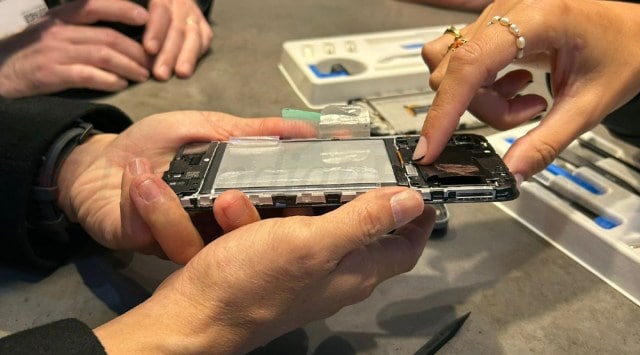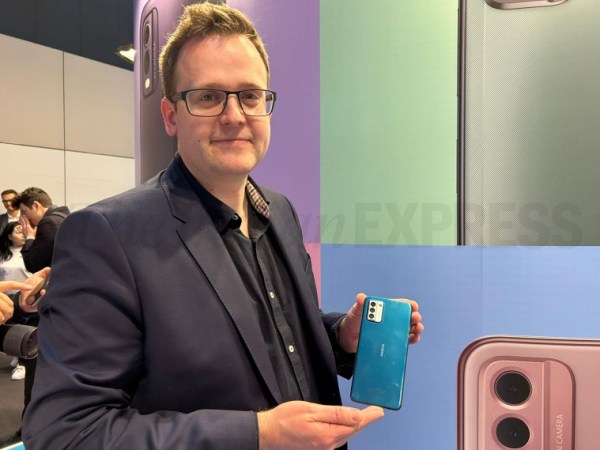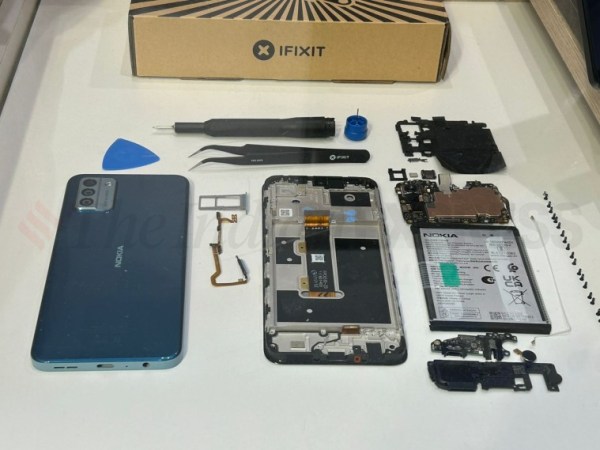HMD Global, the Finnish manufacturer of Nokia smartphones, isn’t showing off crazy concept devices or foldable phones as has been the trend at this year’s Mobile World Congress in Barcelona. Instead, the company is showcasing a phone that can be repaired in minutes.
“We are bringing software updates down to lower price points, we are also building our phones with recycled materials, and now the next step in our longevity journey is really how do we make it easy for a consumer themselves to repair something, so they can keep the device for longer,” Nokia Product Marketing Chief Adam Ferguson tells indianexpress.com in an interview on the sidelines of the Mobile World Congress.

 Nokia Product Marketing Chief Adam Ferguson with Nokia G22 (Image credit: Anuj Bhatia / Indian Express)
Nokia Product Marketing Chief Adam Ferguson with Nokia G22 (Image credit: Anuj Bhatia / Indian Express)
HMD Global’s Nokia G22 is the first smartphone that can be easily repaired in minutes, all by a user at home without going to a technician. The company claims the phone’s battery can be replaced in five minutes and its screen in roughly 20 minutes.
“There are four elements of the device that are most often repaired, which includes the battery, the screen in case that gets cracked, the charging port, and you have the back cover. We have looked at those four areas and thought why not make our devices much easier for a user to repair,” Ferguson explains.
To achieve a more repairable design, the company had to completely alter the design of the Nokia G22. For example, heating is no longer needed to remove the back cover. Users also no longer need alcohol wipes or gel in order to be able to take the battery out. “We have cut out 50% of the steps you would have needed to repair it versus a previous generation device,” Ferguson said, adding that the reparability approach required a lot of fundamental changes to the structure.
HMD Global is working with repair specialists iFixit to provide users with the necessary replacement parts, tools, and guides. All users need is a guitar pick and a #00 screwdriver. As Ferguson puts out, the intention is to make smartphone repairs uncomplicated without any fear, which has been the case if someone breaks the phone’s screen or the phone won’t charge anymore. Ferguson hopes this initiative not only drives the behaviour making it seem really simple to fix a phone but eventually the cost of repairing a smartphone will also come down.
But the repairability of your phone will depend on the type of device you have, and the age of the device. Ferguson says they chose the Nokia G22 as the first device that users can repair themselves due to the price point it caters to. Nokia G22 is an affordable smartphone with a recyclable plastic back, has an IP52 rating for dust and water resistance and is powered by a Unisoc T606 processor.
Story continues below this ad
 HMD Global has collaborated with iFixit to offer tools and spares to Nokia G22 (Image credit: Anuj Bhatia / Indian Express)
HMD Global has collaborated with iFixit to offer tools and spares to Nokia G22 (Image credit: Anuj Bhatia / Indian Express)
“The Nokia G22 is available to a lot of people, which means everyone can access repairability,” he said. But Ferguson also added that bringing easy reparability to high-end smartphones can be a bit complicated due to less reparable design. “As you move up and down the pricing structure, there are challenges. The short answer is this is a journey and we haven’t got those immediate answers now.” Ferguson said the company will bring Do-it-yourself (DIY) reparability to other parts of the portfolio in the near future.
In India, which HMD Global counts as a critical market, the brand will be working with local partners to be able to provide tools and repair guides to fix a phone. Although Ferguson didn’t share many details about how the DIY capability programme would work out in India, he did mention that the company will take advantage of its massive Nokia Care network to provide tools needed to self-repair a phone.
Smartphone companies are increasingly under pressure to make phones last longer and easy to repair and reuse amid pressure from regulators to make electronic devices more sustainable. The European Commission (EU) wants to drastically increase the recycling of electronic goods, which are hard to repair, replace batteries or upgrade.
The “right to repair” movement is also gaining steam in the US where many states have considered legislation that would force manufacturers to make parts and tools available to third parties, including individuals. Apple, for instance, has been offering its self-repair programme which allows users to buy genuine parts and repair kits for certain iPhones and Macs from 2020. Meanwhile, Samsung and Google have partnered with iFixit to sell replacement parts. But repairing an iPhone or a Galaxy smartphone isn’t as easy as these companies initially promised.
Story continues below this ad
For Ferguson, longevity of a smartphone is what the consumers want with many holding on to their devices for up to four years in some parts of Europe. The concept of reparability is the next logical step HMD Global wants to take for the sustainable future, which is also a big theme at the Mobile World Congress.
Ferguson said the company is not waiting for other manufacturers to make easy-to-repair phones. “Our users are telling us this is what we want and we want it now. When the legislation catches up, and when the other manufacturers catch up as well. Fantastic…it’s good news for everyone but we’re not going to wait.”



 Nokia Product Marketing Chief Adam Ferguson with Nokia G22 (Image credit: Anuj Bhatia / Indian Express)
Nokia Product Marketing Chief Adam Ferguson with Nokia G22 (Image credit: Anuj Bhatia / Indian Express) HMD Global has collaborated with iFixit to offer tools and spares to Nokia G22 (Image credit: Anuj Bhatia /
HMD Global has collaborated with iFixit to offer tools and spares to Nokia G22 (Image credit: Anuj Bhatia / 





